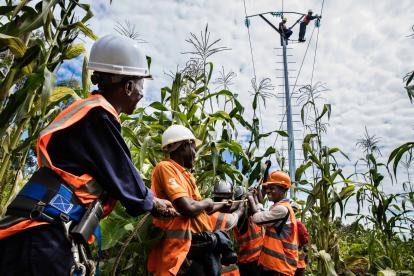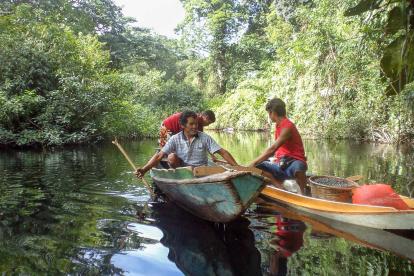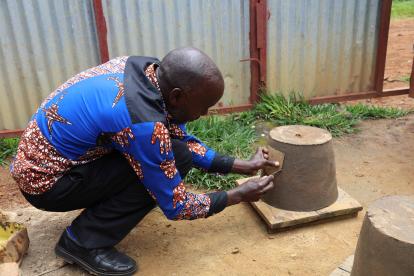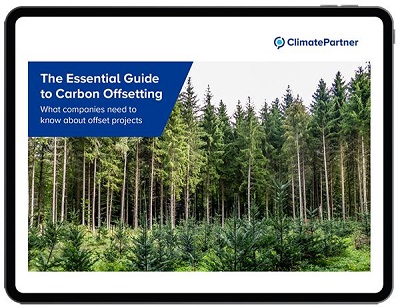All you need to know about carbon offset projects
February 28, 2022How do carbon offset projects contribute to climate neutrality?
by Nina Piel and Jennifer Knöpfle, Carbon Offset and Green Energy Services ClimatePartner
Ambitious corporate climate action can be a challenge. You already identified your company’s emissions sources, calculated greenhouse gas (GHG) emissions, and implemented strict reduction measures – and yet there are unabated emissions that can neither be reduced nor avoided. Technologies are currently being developed that will further support tougher reduction goals along a company’s transformation path. In the meantime, there is something that can be done right now to compensate your unabated emissions – it is the investment in internationally recognised carbon offset projects.
If implemented in the right way, these offset projects can have a real positive impact on the climate and support sustainable development on site. If implemented incorrectly, they do not fulfil their tasks properly, deliver insufficient results or just serve as a cheap alternative to more elaborate measures for real change in companies.
So, what is a carbon offset project?
Carbon offset projects are verified activities of environmental conservation, energy efficiency or renewable energy which reduce, avoid, or remove greenhouse gas emissions from the atmosphere and contribute to the mitigation of climate change. According to Article 12 of the Kyoto Protocol, governments and companies may fund carbon offset projects to achieve their emission reduction targets and to promote sustainable development in developing countries. Their financial support enables these project activities and subsequently compensates for CO2 emissions that were released to the atmosphere elsewhere.
From the protection of ecosystems over afforestation of new, or reforestation of degraded land to the expansion of renewable energy sources – carbon offset projects involve various efforts in climate action.

And not only that: social impact initiatives also boost sustainable development. The distribution of clean drinking water or clean cooking stoves for example enhance water and air quality. The development of infrastructure creates employment opportunities, enables education, and improves living conditions for local communities.
Hydropower in Virunga National Park, D.R. Kongo: By generating sustainable energy with a run-of-river power plant, about 4 million people gain access to electricity.
These additional positive effects are of particular importance to us as long-term climate action goes together with sustainable development, prosperity and peace for all. The United Nations 17 Sustainable Development Goals (SDGs) can be seen as guiding principles when selecting carbon offset projects.
Building a framework with international standards for carbon offset projects
International standards are the basis of any high-quality carbon offset project – they provide a framework: for project design, set-up, CO2-accounting, and monitoring. Standards make the carbon offset system and the projects resilient, traceable, and credible.
In the voluntary market, two major standards stand out: the Gold Standard (GS) and the Verified Carbon Standard (VCS), each of them with a different technology focus. VCS focuses on forest conservation projects (REDD+) and to a lesser extent on reforestation-, afforestation-, and renewable energy projects. Gold Standard on the other hand focuses on social development projects such as clean cookstoves, clean drinking water, agroforestry, reforestation, and renewable energy. All international standards set a quality baseline for carbon offset projects.
Four criteria that are key to carbon offset projects
Besides standard-specific criteria, projects must meet four basic requirements, which originate from the Greenhouse Gas (GHG) Protocol and the International Carbon Reduction and Offset Alliance (ICROA), across all standards to be considered a carbon offset project and to be certified in the official registries:
● Additionality
● Exclusion of double counting
● Permanence
● Regular independent audits
These terms may seem a little general in their listing but they make a very concrete contribution to climate action...
1 Proof of added value to climate action through additionality
The additionality of a carbon offset project is particularly crucial. Project based GHG emissions reductions can only be claimed additional if the project activity ‘would not have happened anyway’. A project is considered additional if it results in lower carbon emissions compared to the current scenario without the project.
Additionality also implies that the implementation of the project would not have been possible without the additional funding through emission reduction certificates. The project therefore relies on revenue from the sale of certificates. Projects that are economically viable and / or would be realised independent of carbon offset revenues are not eligible to be registered as carbon offset projects.

Forest Protection in Pará, Brazil: The local project protects the forest and its resident families from any commercial deforestation.
Let’s exemplify this: existing forests naturally store carbon. A contribution to the reduction of carbon emissions would be to create new forests or to protect threatened forest areas. To show that a project provides this additional impact, the contribution to CO2 reduction must be clearly measurable.
2 Double counting must be avoided
Carbon certificates can only be sold and credited once, for example they cannot be claimed on the voluntary market and simultaneously on the compliance market. To ensure this, carbon credits are tagged with a unique serial number. Each serial number represents one tonne of reduced CO2-emissions. Once a carbon credit is sold, the certificate must be retired. For this, certificates are stored in registry accounts. When an offset is booked through ClimatePartner, the registry retirement is done via our TÜV Austria approved tools. The retirement in the registry ensures that each certificate can only be used once, as it cannot be sold afterwards, thus preventing double counting.
Double counting is a risk that could occur if a project is in a country that engages in emissions trading. Here, carbon credits run the risk of being claimed by the host country or a second buyer and in the voluntary market. For example, double counting would apply if a project developer wanted to declare a German solar power plant producing green electricity as a carbon offset project as electricity from renewable energy sources already counts towards national emission reduction targets in Germany. Double counting is one of the reasons there are still no certified carbon offset projects located in Germany or Europe as industrialised countries have national reduction targets – or, correctly, Nationally Determined Contributions (NDCs).
A hot topic in the field of carbon offset projects is the question of what happens when developing and emerging countries receive NDCs as envisaged by the Paris Agreement. How can double counting then be prevented? Article 6.4 of the Paris Climate Agreement addresses international cooperation and defines precise rules to implement the agreement, having been in place since January 2021 already. However, negotiations in the Conference of the Parties (COP26) on this have not yet been completed. One solution to avoid double counting would be to make corresponding adjustments, i.e., the national emissions balance of the project's host country would be adjusted when carbon credits are sold. For example, if a carbon offset project in Brazil were to sell its emission credits on the voluntary market, Brazil would not be able to use these emission reductions to achieve its own climate target. So, COP26 is eagerly awaited as a decision on Article 6.4 is urgently needed.
3 Long-term reductions of carbon emissions through permanence
The emission savings of a carbon offset project must be permanent. Typical examples are afforestation and forest protection projects as those guarantee long-term emission storage. Trees and soils sequester carbon and contribute to emission reductions. As the forest grows, it adds to its removal capacities. The project developer must therefore ensure that the forest areas will be maintained and protected permanently. If those stored emissions are released again – for instance, if a fire occurs – the project no longer fulfils its compensation purpose.
But what if there are other potential threats to the project area and its emissions savings? A common way to counter such risks are buffer regulations. In this case quality standards assess potential risk scenarios and set buffers. A part of the generated certificates is being transferred to a central certificate account, which is managed by the quality standard. This ensures the possibility to diminish risks in case of an emergency.
4 Verification of carbon offset projects through independent audits
Independent audits to verify project activities are another crucial criterion for carbon offset projects. During project development and implementation, there are various stages that require validation and verification to meet internationally recognized standards such as the Gold Standard or VCS:
When a carbon offset project is being designed by the project developers, they write a so-called Project Design Document (PDD). It describes, among other things, the intended project activities, the methodological approach, and provides calculation of the estimated emission reductions. To verify that all assumptions made during the project design phase are feasible and correct, an independent third-party auditor checks all underlying documents, facts, and figures in a Validation Report. Here, a neutral auditor, e.g., TÜV Nord, evaluates in a systematic and documented process if a project’s activity is likely to reach the planned results.
In the next phase, the project developer monitors the project activities and gathers the project’s data. Upon completion of the monitoring phase, a Verification Report is carried out to assess whether a project’s reported results have been achieved. This also includes visits to the project area. An auditor examining a cookstove project for example checks onsite if the cookstoves are being used by households and whether broken parts have been replaced by the project. This monitoring and verification process is repeated on a regular basis every 1-5 years during the lifetime of the project. Through regular independent audits project developers have the certainty that they have achieved what they intended, and project supporters have certainty about the impact and effectiveness of the project.

Efficient cookstoves in Nyungwe, Ruanda: More efficient cooking stoves can reduce emissions as well as the heavy smoke exposure of families in southwestern Ruanda.
In addition to these four official criteria, a due-diligence review of each project should be done to ensure that a carbon offset project adheres to highest quality standards. The quality of a project generally starts with the project developer.
Carbon offset projects support the path to carbon neutrality
Carbon offset projects are a key instrument in reaching carbon neutrality. High-quality projects are certified by an international standard such as VCS or Gold Standard to ensure a quality baseline. Across all standards, a project must meet the four requirements additionality, permanence, exclusion of double counting and independent audit.
While we are transitioning to alternative energy sources, sustainable mobility and to new technologies that aim for a zero-carbon future – supporting impactful carbon offset projects is an effective action a company can take immediately. It goes without saying, however, that carbon offsetting is a relevant activity along with reductions and avoidance measures.
There’s much more to learn about carbon offset projects and carbon neutrality – so join us in our frequent Climate Action Academy or Deep Dive sessions. Sign up now!
